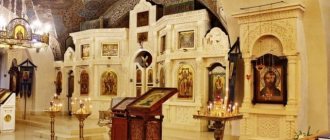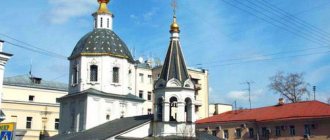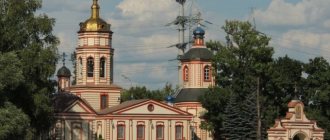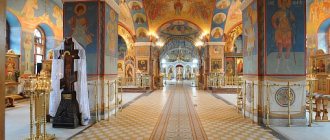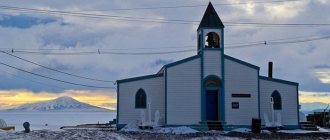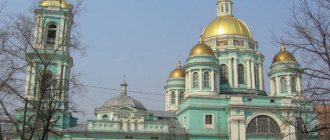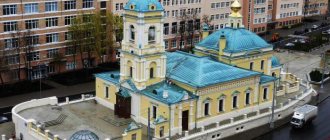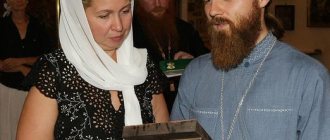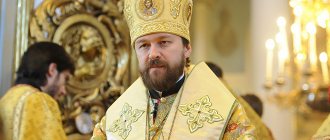The Presentation of the Lord is the twelfth everlasting holiday, which is celebrated annually on February 15 , February 2, old style. Established in memory of the bringing of Christ the Savior to the Cathedral on the 40th day after birth to perform the established sacrifice. “ Now do you let go of your servant, O Master, ” this saying of Elder Simeon, known from church services and even secular literature and music, is the leitmotif of the holiday. The Church Slavonic word “meeting” can be translated into Russian with the word “meeting”. The meeting of the Old Testament with the New, the meeting of Simeon the God-Receiver and Anna the Prophetess with the Lord Jesus Christ. The word “meeting” most fully conveys the meaning of this event, because it means not just a meeting, but a meeting of the lesser with the greater, of man with God.
Meeting of the Lord. Holiday event
Believers learn the details of the event of the Presentation of the Lord from the Gospel of Luke. According to the Old Testament law of Moses, the firstborn, i.e. the eldest son was dedicated to God. This was a reminder of how, on the night before the Jews left Egypt, the Angel of the Lord killed all the firstborn of Egypt, children and animals, leaving the Jewish houses unharmed, in which the doorpost was anointed with sacrificial blood.
At the time of the birth of the Lord, it was customary for the firstborn to bring a symbolic ransom to the temple in Jerusalem. A woman who gave birth to a son was required to undergo 40 days of purification, after which she had to make a sacrifice - a one-year-old lamb and a young dove or turtle dove. If the family was poor, then only a pair of doves were brought to the temple (Lev. 12:6-8).
According to legend, after the Birth of Christ the holy family lived in Bethlehem, in the house of their relative Salome. On the 40th day, Joseph the Betrothed and the Most Holy Theotokos with the Infant Christ headed to Jerusalem to fulfill the commands of the Law. They were met in the temple by Elder Simeon , who had been waiting for this meeting for many years of his righteous and pious life. According to legend, he was one of 72 Jewish interpreters who translated the Holy Scriptures into Greek under King Ptolemy II Philadelphus (285–247 BC). When Simeon translated the words of the prophet Isaiah, “Behold, the virgin will bear a Son,” he decided that this was a mistake, and wanted to write “young woman” instead of the virgin. At that same moment, an Angel of the Lord appeared and held his hand. Simeon was promised that he would not die until Isaiah's prophecy was fulfilled.
And now, many years later, the meeting came, the meeting of the Old and New Testaments. Simeon took the Lord, a 40-day-old baby, into his arms and joyfully exclaimed:
Nn7e thou shalt let thy servant go abroad, according to thy word; ћkw vid1deste џchi my2 salvation is yours, є4zhe є3si2 ўprepared in front of all < people; light in the blood of kzhkom and3 glory of your people.
This prayer is now read at every service at the end of Vespers. After inspired words addressed to the Lord, Simeon greeted the Mother of God and Joseph. Then, turning to the Mother of God, the elder said:
This lies for the fall and rebellion of many in Israel and for the subject of controversy. And a weapon will pierce your own soul (Luke 2:34–35).
The Feast of the Presentation of the Lord reminds us of the upcoming Great Lent and Holy Week - the time of remembering the sufferings on the Cross and the death of the Lord. It was then that Simeon’s prophetic words were fulfilled, because the Most Holy Theotokos suffered in soul along with her Son. Anna the prophetess , an 84-year-old widow who lived at the temple and served God with fasting and prayer day and night, also recognized the Lord, as the Evangelist Luke says about her. Anna prophesied about Christ and spoke about him to all the people who were awaiting His coming with faith and hope. Probably, the worship of the Magi, which is remembered on the feast of the Nativity of Christ, occurred after the events of the Presentation of the Lord. After all, after this the holy family fled to Egypt. Only after the death of Herod did they return to Galilee, to the city of Nazareth.
Simeon the God-Receiver died, according to legend, in the 360th year of his life. He was not afraid of death, because the promise given to him and all people was fulfilled. Simeon held the Messiah in his arms! And his soul now departed into eternity to tell all the righteous of the Old Testament that the Lord became incarnate and came to earth to save humanity from sin and death.
The Old Testament custom of 40 days of cleansing after the birth of a child is preserved in Orthodoxy. Usually on the 40th day or later, the mother and child come to the temple. The priest reads the prayers of the “fortieth day”, after which the woman can touch the shrine and pray in the temple. Before this, she is supposed to stand in the vestibule. The priest also brings the baby into the temple, and the boy also into the Altar. This rite can be performed earlier, on the day of baptism, if it occurs before the 40th day.
Meeting of the Lord. history of the holiday
The Feast of the Presentation of the Lord is one of the most ancient. Already in the 4th century, it was solemnly celebrated in the Jerusalem Church, completing the 40-day holiday sequence from Epiphany, also called Epiphany . This is mentioned by Etheria , a pilgrim from modern Europe who traveled to the Holy Land at the end of the 4th century:
The fortieth day of Epiphany is celebrated here with great honor. On this day there is a procession to Anastasis, and everyone marches, and everything is done in order with the greatest triumph, as if on Easter. All the presbyters, and then the bishop, preach, always talking about the place in the Gospel where on the fortieth day Joseph and Mary brought the Lord to the Temple, and Simeon and Anna the prophetess, the daughter of Phanuel, saw Him, and about their words that they said when they saw the Lord, and about the offering that the parents brought. And after this, having sent everything in the usual order, they perform the Liturgy, and then there is dismissal.
Then the holiday spread to all local Churches and began to be celebrated in Constantinople and Rome. But, despite its ancient origin, it was not one of the solemn and great. in the Twelve Feasts only in 544.
In the 6th century, during the reign of Emperor Justinian (527–565), Byzantium suffered many disasters. First there was an earthquake in Antioch, accompanied by numerous casualties. Then a pestilence appeared - an epidemic of smallpox brought from Africa. Tradition says that in difficult days, when the entire people were experiencing terrible troubles and illnesses, a pious Christian had a vision: the Feast of the Presentation of the Lord should be celebrated more solemnly. On this day a solemn service was held with an all-night vigil and procession of the cross.
The feast of the Presentation of the Lord is mentioned in the sermons of the Hieromartyr Methodius of Patara (c. 260–312), St. Cyril of Jerusalem (315–386), St. Gregory the Theologian (329–389), St. Amphilochius of Iconium (c. 340 - after 394), St. Gregory of Nyssa (c. 335–394), St. John Chrysostom (c. 347–407).
Divine service for the Feast of the Presentation of the Lord
The Presentation of the Lord is an unusual holiday. He is both the Lord's and the Mother of God. Reading the troparion for the holiday, believers turn to the Most Holy Theotokos:
Raduisz њradovannaz btsde dv7o, i3z8 vosіS righteous saint хрт0съ bG our, enlighten the dark. cheerful1sz and3 you2 are older than the righteous, receiving in the handsY freedom1s of ours, giving us the resurrection.
Troparion for the holiday, Russian text:
Rejoice, O Virgin Mary, who has received joy from the Lord, for from You has arisen the Sun of Truth, Christ our God, who enlightens those in ignorance. Rejoice also, O righteous elder, who has accepted into your arms the Liberator of our souls, who gives us resurrection.
In kontakion we turn to the Lord:
And also ўtr0bu dv7chu њс™и1в ржктв0м SI2, и3 рузе зімнні злізівів, ћћћћћћћћћћћћћћћћћћћ ћћћћћћ ћћћћ ћћћћћ ћћћћ ћћћћ ћћћћ ћћћћ podbashno predv1v њћ, ћћћћћћ ћћ ћћ ћћ ћћћћ podbashno predv1v њ, и3 єнне єзслъ є3сi2 хрте b9е us. but peace our life in battle, and strengthen our hearts, and love it more than others.
Kontakion for the holiday. Russian text:
Jesus Christ, who sanctified the Virgin’s womb with His Birth and blessed Simeon’s embrace, as it should be; hastened to save us, and has now saved us, O Christ our God. Give peace to society in the midst of wars and strengthen the people You love, O One Lover of Mankind.
Also, the magnification of the holiday, addressed to the Lord Jesus Christ, simultaneously glorifies the Mother of God:
We magnify you, life-giving he7, and3 we honor8 your most precious death2. є3yu1 already according to the law nhne brought z to the 8th church of gDnyu.
Festive stichera were written by famous church hymnographers - Anatoly , Patriarch of Constantinagrad (5th century); Andrew of Crete (VII century); Cosmas of Maium , John of Damascus , Patriarch Herman (8th century); Joseph the Studite (9th century) and many others. They not only tell us about the events of the holiday, but also explain their meaning.
The verses for Vespers, written by Patriarch Herman, say that the Baby, who is held in the arms of the elder, is God, who took on flesh to save people:
Gli, simeNe, whom2 noseS on handu2 in8 tsRkvi rejoicesz; to whom you call and3 cry, nn7e freedom1хъсz, vid1ехъ bо з7са мегв2; this є4st t dv7y was born. this є4 is t bGa bGb word, incarnate1 for our sake, and3 save a person. tomY bow1msz.
“In the Ancient Days I became a man of flesh,” believers sing the words of church hymns and are amazed at the humility of God. The Lord, who gave the Law to people, is brought by the Mother of God to the temple of God in order to fulfill what has been established: “...according to the Law the Creator, the Law is complete, into the Church is brought…”
Here is the stichera of Andrei of Crete explaining to us what the two young doves sacrificed on the day of the Presentation of the Lord mean: “…ћkw the monastery of the unclean church, and 3 t kzhk 0vyz people. The dove has two chicks, one for the old boss and the new one..."
The festive canon, written by Cosmas Maiumsky , has the borderline: “ The old man joyfully embraces Christ .” This is the main idea of the canon. In the original Greek text, the first letters of each verse formed this phrase. Each verse of the canon not only tells some detail of the festive event, but also explains its meaning and symbol. At the same time, we also recall prophecies, for example, of Isaiah, to whom the seraphim gave a burning coal to cleanse his lips.
Cleansing and 3сaіz t Seraphim ќgl reception. the old man speaks to the world, you use pincers, your hands enlighten ms. having given me2 є3г0же n0sishi, the light of the unevening, (i.e., unquenchable) and3 the world њpossessing (i.e., dominating).
As a rule, the ninth hymn of the holiday canon has a chorus - a short laudatory appeal to Christ or the Mother of God, depending on the holiday. The choir repeats it before each verse. The Canon of the Presentation differs from the others in this too: it has not one chorus for all verses, but 14 different ones! This allows worshipers to better understand and feel the events of two thousand years ago. “BGon0se simeHne, prii3di2 podij3mi2 hrta, є3g0zhe rod2 dv7a chtcaz mRjz. The elder Simeon, the father of the law, will strike the hands of all. It is not the old man who holds me, but I hold him. you will not let me go."
Library of the Russian Faith Canon of the Presentation of the Lord →
Read online
In the proverbs: in the 1st proverb (from the books “Exodus” and “Leviticus”) the Old Testament law is recalled to dedicate the firstborn to God; in the 2nd proverb (Isaiah I, 1-12) the vision of St. Isaiah is described, who saw the God of Hosts sitting on the Throne and surrounded by Angels; The Third Proverbs (Isaiah XIX, 1, 3–5, 12, 16, 19–21) contains a prophecy about the flight to Egypt, the fall of Egyptian idols before the Lord and the conversion of the Egyptians to God. The events predicted in this prophecy are not described in the Gospel. An ancient legend tells that during the Savior’s stay in Egypt, in the city of Iliopolis, the pagan gods of this city fell before Jesus Christ and were crushed to dust.
The Apostle (Heb. VII, 7-17) speaks of the superiority of the high priesthood of Christ and the sacrifices He made before the Old Testament sacrifices and the abolition of the Old Testament with the coming of the Savior. The Gospel (Luke II, 23–40) tells of the bringing of the infant Christ into the temple.
Thus, people who pray not only during the Liturgy, but also come for the evening service, have the opportunity to learn not only the description and history of the holiday event, but to understand its meaning and significance for each person.
Church of the Presentation of the Lord in Serpukhov
It is known that in the 15th century, blacksmiths lived on this side of the Nara River, and Saints Cosmas and Damian are considered the patrons of blacksmiths, so a wooden church was originally built in their honor. The first local legend dates back to this period: in the 15th century, in the family of a local priest Vasily, a boy Ivan was born, who later became Bishop Barsanuphius, educator of the Tatars in Kazan and Tver.
By the beginning of the 18th century, a stone church was erected on the site of a wooden church according to the principle common at that time - an eight-figure on a four-piece. The new building is directed towards the sky and filled with light - in the upper part of the temple there are 6 symmetrical windows in the octagon, in the lower part there are 7 windows in the quadrangle. The altar of the church today is considered unique, as it has retained its original three-apse appearance, it looks like a trefoil, while in other churches in Serpukhov the altars were rebuilt.
The new temple is being consecrated in honor of the holiday of the meeting of God and man - Candlemas. From the Holy Scriptures we know about the events of this holiday - the infant Christ is traditionally brought to the temple by his mother, the Virgin Mary, on the 40th day, and they are met there by Elder Simeon and the prophetess Anna with words that are still pronounced every evening in churches - Now you release your servant, Master , according to Your word, be in peace, since with my own eyes I saw Your coming into the world to save people from sin. In the lives of each of us, encounters with God often occur; it is only important to be more attentive and notice them, drawing benefit from them for life. And for 315 years the Sretensky Church has been reminding us of a meeting with God.
Also related to this period is another legend about St. Herman of Alaska; the veneration of St. Herman in Serpukhov and in the Sretenskaya Church as the place of the beginning of the spiritual life of St. Herman in the 17th century was based on the erroneous opinion of our contemporary historian Sergei Anatolievich Korsun. This saint became known as a participant in an educational mission in Alaska, and by his example of personal piety he attracted local Aleut residents to the Orthodox faith. Miraculously, a particle of the relics of Father Herman was transferred to our church and placed with honor in a beautiful casket - a reliquary. Further research into the life of the saint revealed the true homeland of St. Herman - a village near Voronezh, but in the Sretensky Church everyone still prays with love and faith to the Alaskan Wonderworker.
During this historical period, the church was rebuilt several times, increasing the space for worshipers; at the beginning of the 19th century, two doors with altars were added in honor of the already known Cosmas and Damian and the Tolga Icon of the Mother of God. At the end of the 19th century, a massive three-story bell tower was built. This bell tower, like many other churches, was destroyed in the 20th century; the temple was closed in the 30s. The last priest of the temple was Archpriest Alexander Vladychensky, a very educated man, he taught the law of God in various educational institutions in the city of Serpukhov. He had nine children in his family. During the years of persecution of the church, he was shot along with another priest of the Sretensky Church, Alexander Uspensky, and two singing nuns Glikeria Savelyeva and Tatyana Ryabchenkova.
In 2000, the church building was returned to the believers, since 2008 the Divine Liturgy began to be celebrated in the church every Sunday, a preliminary restoration project was developed, and in 2011 a golden dome was installed over the church. The walls of the octagon were restored and painted with bright, cheerful colors. In 2015, a large-scale renovation was carried out inside the temple - the walls, along with the ceiling, were cleaned of soot and mold, again plastered and whitewashed. The church was given a wonderful iconostasis, and beautiful tiles were laid on the floor. In 2021, a large particle of the relics of one of the 12 apostles was donated to the temple; now believers coming to the Sretensky Church are blessed by the disciple and contemporary of Jesus Christ, his apostle Bartholomew.
Recently, the heating of the church was switched from stove to water, although gas has not yet been connected to the church and the boiler room is still running on diesel fuel. The territory of the temple is also being beautified; a preliminary design for landscaping the territory has been developed, according to which 20 rose bushes and other flowers were planted near the temple in 2021.
Much has already been done, but even more remains to be done - a large refectory part of the temple and the lost bell tower are subject to restoration and restoration, it is necessary to switch the temple boiler room to gas, build a building for the Sunday school and continue to beautify the territory. And of course, the most important task facing us is the beautification of our souls and our lives in the place with the temple. So that every person who comes to the temple would draw strength for himself to do good in his family, at his work, in his city and country, thereby decorating his soul and getting closer to the love of God and happiness in Eternal life.
Meeting of the Lord. Folk traditions and customs
The Presentation of the Lord is perhaps the only holiday that is celebrated differently by Old Believers and New Believers. The fact is that sometimes Candlemas coincides with the first day of Lent. In the ancient liturgical Charters, according to which services are still performed among the Old Believers, such a case is provided for. The holiday service is combined with the Lenten service. And in this case, the New Believers move the holiday one day earlier, to Forgiveness Sunday. In the Old Believer periodicals of the early 20th century, this is described in great detail.
Another difference is that the New Believers in the 17th century borrowed from Catholics the custom of blessing church candles on the feast of the Presentation of the Lord. This rite is contained in the consumer book of Metropolitan Peter Mogila , it was copied from the Roman breviary. The fact is that in the West this holiday is called “Bright Mass”; during the mass everyone holds lighted candles in their hands. This custom probably originates from the ancient Jerusalem Church, where in the middle of the 5th century a procession of the cross was held and during the Liturgy the worshipers held burning candles in their hands. In Byzantium, such a custom no longer existed, therefore, since the time of the Baptism of Rus', our ancestors prayed “with candles” only during polyeleos. And now in the Old Believer Church, on the eve of the Twelve Feasts, in the middle of the evening service, while singing the magnification (polyeleos), the worshipers take burning candles in their hands and hold them almost until the very end of the evening service.
As for folk traditions, among the peasants the Presentation of the Lord was not considered a big holiday. Very often, peasants, especially illiterate ones, did not even know what event the Church was remembering on this day, and the very name of the holiday - “Candlemas” - was explained in such a way that on this day winter meets summer, i.e. frosts begin to weaken and You can feel the approach of spring in the air. Attributing to Candlemas only the significance of a calendar milestone, the peasants associated many agricultural signs with this day: “On Candlemas there will be snow on Candlemas, rain in the spring,” they said, wondering about future rains. Drops on this day foreshadow the harvest of wheat, and the wind foretells the fertility of fruit trees, which is why gardeners, coming from Matins, “shake the trees with their hands so that they will bear fruit.” If Candlemas Day is calm and red, then in the summer the flax and so on will be good. The weather of that day was also used to judge the herb harvest, for which they threw a stick across the road and observed: if the snow sweeps it away, then the livestock feed will also be “swept away,” i.e., the herbs will be expensive. Finally, on Candlemas Day, housewives began to feed the chickens intensively so that they would have socks.
As for the religious customs associated with this day, they almost did not exist throughout Great Russia, only in some places (for example, in the Vologda province) peasants walked around their houses with an icon of the Presentation of the Lord or the Savior, and when the icon was brought back to the house , then the whole family, with the householder at the head, fell on their faces with the exclamation: “Lord our God, come to us and bless us.”
History[edit]
The Church of the Presentation had a predecessor - a modest wooden church in the name of the Holy Great Martyr Demetrius of Thessaloniki. It is mentioned in the oldest surviving document of Murom - the Hundred Book of the Murom Posad of 1574.
At the end of the 18th century, a small warm wooden church was built at the Demetrius Church in the name of the Presentation of the Lord. Apparently, this was due to the growth of the city's population, as well as the desire of parishioners to have a temple for a year-round cycle of services.
Unfortunately, the exact date of construction of the wooden Sretenskaya Church has not been preserved. But it is reliably known that in 1795, instead of the dilapidated wooden churches of Demetrius of Thessaloniki and the Presentation of the Lord, the stone Sretenskaya Church was built, which has survived to this day. The main initiator of the construction was the Murom merchant of the first guild Ivan Nikiforovich Zvorykin.
During construction, the new temple was placed somewhat away from the previous buildings. This is due to the fact that at the end of the 18th century the city was rebuilt according to a new quarterly plan approved by Catherine II, with straight, wide streets. Since then, the street has received the name Sretenskaya. However, this did not bother city residents until the middle of the 19th century. call the street the old fashioned way – Dimitrievskaya.
After the construction of the new temple, some icons from the previous wooden churches were transferred to the poor rural churches of the Goritsky churchyard, Murom district. Sretensky Church was decorated with new icons and church utensils, purchased at the expense of parishioners.
In 1801, the parish of the ancient Church of the Archangel Michael was assigned to the Sretenskaya Church. It was located in the very center of Murom - inside the former wooden Kremlin (now the territory of Oka Park). However, this parish was soon abolished, and in memory of him in 1829, a chapel in the name of Archangel Michael was built in the Sretenskaya Church.
Until 1888, the Sretensky Church stood unchanged. From 1888 to 1892, extensive construction work took place in it: the temple refectory was dismantled to its foundations and rebuilt on a much larger scale. The thrones in the meal were consecrated with the same name as before.
Murom local historian A.A. Epanchin recorded unique information about the bells of the Presentation Church, thrown from the bell tower in the late 1920s. According to this information, there were ten bells in the belfry. The first, largest, weighing 25,308 pounds, was cast in Yaroslavna in 1857. The second, a polyeleos bell, cast in Yaroslavl, weighed 124 pounds 6 pounds. The third is an everyday bell, cast in Murom on June 6, 1792, weighing 42 pounds. The fourth bell weighed 21 poods 29 pounds. There is no information about the fifth bell. The sixth bell, weighing 16 poods 14 pounds, was cast in Yaroslavl. The seventh bell came from the city of Slobodskaya Vyatka province, weighing 8 pounds. 34 lbs. The eighth bell weighed 1 pood 16 pounds. Ninth - 36 pounds. The tenth bell - the city of Slobodskaya Vyatka province, 29 pounds.
After the revolution of 1917, the Sretenskaya Church shared the sad fate of many Murom churches. On May 8, 1922, under the pretext of providing assistance to the starving Volga region, church silver with a total weight of 1 pood, 1 pound, 44 spools, which amounted to approximately 16.5 kg, was confiscated from the church. Among the confiscated property were thirteen robes from icons, a silver setting of the Gospel, a silver censer, as well as crowns and pearls adorning the icons.
Several more years passed. On May 31, 1929, at the next plenum of the City Council, it was decided to initiate a petition to the district Executive Committee to close five churches in Murom. Among these temples was the Sretenskaya Church. The closed temple was planned to be used “for cultural needs.” In June 1929, the county Executive Committee approved the resolution of the City Council to close the Sretenskaya Church. They decided to give the building of the former Sretensky Church to a house of culture, the so-called “sanitary education”. In November 1929, the temple also housed a physical education center. One fact is curious: the officially approved document on the closure of the Presentation Church was adopted by the Presidium of the All-Russian Central Executive Committee only on January 20, 1930. The main shrine of the temple - the Sretensky Cross - was transferred to the museum.
By decision of the Presidium of the City Council, the Sretenskaya Church was transferred to the Murom Association of Flax Factories for use as a warehouse for storing flax raw materials. All rent received for the use of the church premises was to go to the cultural needs of the city.
Muromsky old-timer E.N. Dyumina (who came from the Emelyanov family) recalled that at the end of the 1920s, the Sretenskaya Church was surrounded by a green lawn on which daisies bloomed. After the closure of the temple, the premises were given over to storage. There were bales of fiber lying near the church. Children from nearby houses jumped on the soft bales and sacks with great pleasure. Then the building was turned over to an armory for a while, and a sentry began to walk around the church. The lawn ceased to exist. In subsequent years, according to the memoirs of E.N. Dyumina, in the temple there was a garage, and then a bakery, from which the aroma of baked goods spread throughout the neighborhood. When the bakery was closed, the church housed a workshop for making tombstones, which existed until the end of the 1990s.
Sretenskaya Church, left to the mercy of fate, deteriorated and collapsed. Back in the 1920s, bells were thrown from the church bell tower. Subsequently, the bell tower itself was barbarically dismantled into bricks. This happened in 1934, after it was struck by lightning, destroying the upper part of the building. The forgotten temple passed from hand to hand more than once by various tenants and temporary workers. And none of them cared about maintaining the temple. For the temporary tenants of the ancients, the temple was nothing more than an industrial space that did not require attention or care. And only in 1997 the temple was returned to the Vladimir-Suzdal diocese.
On November 8, 2001, in the southern aisle of Dmitry Solunsky, the first liturgy was served, which was conducted by the abbot of the Spassky Monastery, priest Kirill (Epifanov), and the rector of the reviving church, priest Peter Kibalyuk. The name of the latter is associated with large works aimed at restoring the Sretenskaya Church.
Meeting of the Lord. Icons
One of the most ancient and unusual in artistic design image of the Presentation of the Lord, dating from 432–440, is found in the mosaics of the Roman basilica of Santa Maria Maggiore . Features of the composition indicate that the tradition of depicting the feast of the Presentation is still in its infancy.
Meeting. Fragment of the mosaic of the triumphal arch of the Basilica of Santa Maria Maggiore, Rome, 432-440s.
Gradually, over the course of several centuries, a symmetrical compositional scheme was developed in Byzantine art, which depicts the Virgin Mary, Simeon, Joseph the Betrothed and Anna the Prophetess. Between the central figures is an image of the temple throne. The Infant of God can be depicted both in the hands of the Mother of God and in the hands of Simeon.
Pietro Cavallini. Mosaic of the apse of the Basilica of Santa Maria in Trastevere. 1291 Rome, Italy
Icon-epistylium. 2nd half of the 12th century Monastery of St. Catherine, Sinai, Egypt. Fragment
Among the Russian iconographic monuments of the Presentation, one of the most ancient is the fresco of the Church of the Savior on Nereditsa, 12th century.
Fresco Candlemas. Church of the Savior on Nereditsa, 1199
It is no accident that icon painters include a throne with a ciborium in the composition. After all, with its help, the highest meaning of the meeting of the Infant God and Simeon is conveyed.
Icon of the Presentation of the Lord from the iconostasis of the Assumption Cathedral of the Kirillo-Belozersky Monastery. Around 1497
Icon of the Presentation of the Lord. Workshop of Andrei Rublev, 1408. From the iconostasis of the Assumption Cathedral in Vladimir
After the end of the period of iconoclasm, a new asymmetrical iconographic scheme for the presentation of the Presentation appears: the Virgin Mary, righteous Joseph and the prophetess Anna approach the doors of the Temple, on the steps of which stands Simeon.
Icon of the Presentation of the Lord. Novgorod. Late 15th century
In some Russian icons, frescoes and mosaics, the Jerusalem Temple is replaced by a church with Russian domes.
Icon of the Presentation of the Lord. Beginning of the 19th century Palekh. State Museum of Palekh Art
Icon from the workshop of Gury Nikitin's circle. 1680s Kostroma. Yaroslavl Art Museum
Churches of the Presentation of the Lord
The Feast of the Presentation of the Lord has been known to our ancestors since the adoption of Christianity. For some unknown reason, there were very few temples dedicated to this holiday. Of the ancient, pre-schism, the refectory Sretenskaya Church of the Anthony Monastery in Veliky Novgorod . It was built in 1533–36 and originally did not have an altar boss. The upper part of the facades had inset crosses, traditional for Novgorod. The temple was rebuilt in the 18th–19th centuries. This is one of the first pillarless Novgorod churches.
Church of the Presentation of the Lord, Veliky Novgorod. Built in the 16th century, rebuilt in the 18th–19th centuries.
In honor of the Presentation of the Lord, the Assumption Monastery consecrated a temple in the city of Alexandrov, Vladimir Region . The church was built around 1601. The appearance of the church, simple and laconic, is consistent with Pskov architectural traditions. In plan, the temple is divided into two equal parts: a quadrangle, including a rectangular altar, and a northern vestibule. The main volume of the temple, flanked by blades, is slightly raised, covered with a hipped roof and crowned with a blind drum with a dome and a cross. There is a small belfry above the porch. The stone western vestibule of the church with a figured kokoshnik above the entrance has not survived. Later, the architectural appearance of the temple was subject to changes. In 1923, the Sretenskaya Church, along with other churches, was closed. By 1931, the church was occupied by the storage of museum funds, and the local history department was located in the almshouse. In 1993, the temple and a small part of the cells were transferred to the revived Assumption Monastery.
Sretenskaya Church of the Assumption Monastery in the city of Alexandrov, Vladimir region
In honor of the Presentation of the Lord, the Church of the Trinity Monastery in Astrakhan . The temple was built between 1606 and 1620. Subsequently it was rebuilt several times. In 1918, due to the battles that took place in Astrakhan between the Red Army and the White Cossacks, the temple was closed by decision of the military revolutionary authorities. In 1920, Trinity Cathedral was captured by renovationists. Divine services were rarely held there due to the small number of the Renovationist cathedral community. In 1928, the Soviet authorities finally took away the temple. It was looted, the iconostasis was broken and burned. In the 1970s, restoration work began on the territory of the Trinity Monastery.
Vvedenskaya and Sretenskaya churches of the Trinity Monastery in Astrakhan
In honor of the Presentation of the Lord, the chapel of the Church of St. Nicholas of Usokha in Pskov . The church was first built in 1371, and in 1536, after a fire, it was rebuilt. A large, single-domed, three-apse stone church with a northern pillarless aisle in the name of the Presentation of the Lord; on the south side there may have been a warm chapel in the name of John the Evangelist; both aisles had porches. The vestibules - the main one, western, and the side ones - northern and southern - were connected by a gallery. However, alterations of the 17th–19th centuries. significantly distorted the appearance of the temple.
Church of St. Nicholas of Usokha in Pskov
In honor of the Presentation of the Lord, a chapel of the Spaso-Prilutsky Monastery in Vologda . The Spassky Cathedral of the Spaso-Prilutsky Monastery, built in 1537–42, is the first stone church not only in the monastery itself, but in all of Vologda. Until 1537, a wooden cathedral of the same name stood on the site of the current Spassky Cathedral. A wooden church in the name of the All-Merciful Savior and the Feast of the Origin of the Honest Trees of the Life-Giving Cross was erected on the site he chose for the construction of the monastery by the Venerable Demetrius of Prilutsky. When the wooden cathedral burned down, a stone one was built. During the Soviet years, the monastery was plundered. In the 1930s, the monastery housed a transit prison for dispossessed people who were transported to the northern Gulag camps; in the 1950s–70s, the territory of the former monastery was occupied by military warehouses. Only in 1975-79, the central group of monuments with the adjacent territory, after restoration began in 1954, became a branch of the Vologda State Museum-Reserve. Thanks to the scientific restoration carried out in 1954–1975, monuments of the 16th–17th centuries. the supposed original appearance was returned. Currently, the Spaso-Prilutsky Monastery is active.
Spaso-Prilutsky Monastery in Vologda
In honor of the Presentation of the Lord, a chapel of the Annunciation Cathedral in the city of Solvychegodsk, Arkhangelsk Region, . There is an inscription on the building: “...built with the zeal and support of the eminent people the Stroganovs in 1560.” This date marks the beginning of construction of the cathedral. It was finished twenty-four years later. The structure is a large two-pillar, five-domed temple on a high basement. The base of the cathedral is surrounded by a gallery, which was originally open. The façade of the cathedral is given a special charm by the wide ribbon - a frieze of figuratively laid bricks in the upper part of the wall under the zakomari. However, now the cathedral is significantly different from the original. Certain parts of the building have been significantly rebuilt.
Annunciation Cathedral in Solvychegodsk
Currently, only one Old Believer church is consecrated in the name of the Presentation of the Lord - this is the temple of the Russian Old Orthodox Church in the Republic of Buryatia. Congratulations on your patronal holiday!
Moscow diocese
Pilipenko A.D. – senior researcher at SIHM
Moscow region, Serpukhov, st. Karla Marksa, no. 36a
At this point, at least since the description of the Serpukhov Posad by Prince. In 1552, V.S. Funikov built a church in the name of the unmercenary saints Cosmas and Damian - revered in ancient Rus', including as patrons of the blacksmith's craft.
In nearby Kuzmodemyansky Lane Prince. Funikov copied 42 township households: those belonging to blacksmiths, traders, shoemakers, millers, grain producers, etc.; It was here that four of the five buffoons recorded in Sotnaya in 1552 lived. Six courtyard spaces in the alley were empty, and “in the field,” to the west of the church, lay another 20 deserted courtyards of the Kuzmodemyanskaya Slobodka (1). So, for a long time there has been a very busy posad area here, which has seen even more successful times in the past.
According to legend, approx. 1495 in the family of the priest of the Church of St. mchch. Cosmas and Damian were born the future saint - Bishop Barsanuphius of Tver - an outstanding Orthodox missionary, educator of the Tatars, who founded the Transfiguration Monastery in Kazan. According to the life of St. Barsanuphius, written at the turn of the 16th-17th centuries. Metropolitan Hermogenes of Kazan (later Patriarch of Moscow, martyr), Bishop of Tver was the son of a Serpukhov priest, in the world his name was Vasily (2).
In Serpukhov in the 17th century. on the site of Kuzmodemyansky Lane, a street of the same name was already marked (later Verkhnyaya Kazennaya, now K. Marx Street). Here, in the parish of the Church of St. Cosmas and Damian, in 1620 there were 20 courtyards, one of which belonged to the Trinity-Sergius Monastery (3). In 1646, the temple was adjacent to the courtyards of “fodder foreigners” - military and other foreign specialists in the royal service. Many of them were known here by purely Russian names and nicknames; Some of them were Poles or Slavs from the Austrian Empire, but it was not at all noticeable that in the Serpukhov environment these foreigners were considered outcasts: their dwellings stood “between the Posatsk courtyards,” and one of the visitors, warrant officer Ivan Romanov’s son, even raised his adopted son Ekimka Savelyev’s son - native of Tarusa (4). July 27, 1652 The Kosmodemyansky church in the city of Serpukhov receives a blessed letter for the consecration of three altars, including the side altars: in the name of the Epiphany and the Venerables Zosima and Savvaty of Solovetsky (5).
It is traditionally believed that the stone Church of the Presentation, which has survived to this day, was erected on the site of Kosmodemyansky in 1702 (6), however, the antimensions in the newly built Presentation Church with the chapel of Sts. Cosmas and Damian were given out already on June 5, 1700 (7) The Vladychnaya Sloboda also belonged to the Sretensky parish - until 1804, when it was separated into an independent parish with a center in the monastery - and one of the two was transferred there from the Sretensky Church, who served there previously, a priest, a sexton and a sexton (8). In 1813, a refectory with chapels in the name of Sts. was added to the Church of the Presentation. Cosmas and Damian and the Tolga Icon of the Mother of God. In 1833, instead of the tented belfry, the beginning. XVIII century a grandiose bell tower was built. By 1917, the Sretensky parish included 104 households in the city of Serpukhov, and in them there were 367 male and 443 female souls (9).
A persistent local tradition connects with the temple the childhood of St. Herman of Alaska (1757-1837), an educator of the Aleuts, a participant, and then the universally recognized head of the Kodiak mission in Alaska. The monk perfected himself in fasting and prayer among the wild northern nature, was distinguished by his concern for the indigenous population, and even pacified wild bears with his gentleness. He expressed his calling with the words: “I am the lowest servant of these peoples and a nanny.” This turned out to be the best way to preach the Gospel(10).
Despite the losses, the Church of the Presentation is a colorful example of Russian architecture at the turn of the 17th/18th centuries.(11) Its brick octagon on a two-light quadrangle is decorated with relief decoration in the form of a cornice-curb; architraves under keeled gables; paired half-columns, in two tiers, in the corners. The volumes of the three apses of the altar are filled with vigorous energy. This mood of cheerful power is picked up and developed by the forms of later extensions, in particular the volume of the refectory with rounded corners: all cut through by windows and embraced by the booming rhythm of twin Tuscan columns on the sides of these windows. As the apotheosis of the entire building, a three-tiered bell tower built in 1833 rose above the city, twice the height of the main building of the temple and occupying the roadway of the street. Of the decorative details that have come down to us, the most interesting are the mesh lattices made by blacksmiths in the 19th century. in the windows of the temple and refectory.
In the 1930s Sretenskaya Church was closed; Its bell tower was subsequently dismantled. With the formation of a community at the Sretenskaya Church in 2000, a rector appeared at the temple, but the same priest looked after two more parishes entrusted to him, and therefore services were rarely performed. Restoration work progressed just as slowly. Since 2008, the Divine Liturgy began to be celebrated regularly within the walls of the church. A preliminary design for the restoration was developed. On its basis, according to financial possibilities, the temple is being revived. In 2011, for the first time after the desecration of the temple, the Liturgy of the Presanctified Gifts began to be celebrated during Lent. By Easter of the same year, the octagon was restored to its former form - crowned with a gilded dome and a cross.
Here you can see the modern interior of the Sretensky Church and its destroyed refectory.
Patronal holidays:
The Presentation of the Lord - February 15.
Icon of the Mother of God of Tolga - August 21.
St. unmercenaries Cosmas and Damian of Asia - November 14.
Notes:
1. Simson P.F. The history of Serpukhov in connection with the Serpukhov Principality and in general with Russian history. M., 1880, pp. 149-150, 313, 321, 324-325, 328. 2. Volkov I.A., Missionary activity of a native of Serpukhov, St. Barsanofia of Tverskoy in Kazan...// Materials of the fourth scientific and educational Orthodox conference in 2006 “Varlaamo-Afanasyev readings”. Serpukhov, 2008. pp. 37-48. 3. Kholmogorov V. and G. Historical materials about churches and villages of the XVI-XVIII centuries. Issue nine. Volokolamsk and Serpukhov tithes (Moscow province). M., 1896. P. 112. 4. Simson P.F. The history of Serpukhov in connection with the Serpukhov Principality and in general with Russian history. M., 1880, pp. 187-188. 5. Kholmogorov V. and G. Historical materials about churches and villages of the XVI-XVIII centuries. Issue nine. Volokolamsk and Serpukhov tithes (Moscow province). M., 1896. P. 112. 6. TsGAM / before 1917, F. 737. Op. 1. D. 4086. L. 179. 7. Kholmogorov V. and G. Historical materials about churches and villages of the XVI-XVIII centuries. Issue nine. Volokolamsk and Serpukhov tithes (Moscow province). M., 1896. P. 113. 8. TsGAM / before 1917, F. 737 Op. 1. D. 1079. L. 28. 9. Ibid. D. 486. L. 185. 10. The legend about the Serpukhov origin of the Monk Herman has recently been called into question. Biographer of the Alaskan saint Sergei Anatolyevich Korsun in his interview with Return of Russian America - Faith (Eskom). Christian newspaper of the North of Russia (Syktyvkar). June 2007, issue. 1. No. 541. (https:// rusvera. mrezha. ru/ 541/ 9. htm) - pointed to documents in the Central State Historical Archive, certifying that the Reverend was called in the world Yegor Ivanovich Popov and was a peasant of the Kadoma province of Voronezh province, then - soldier
11. The appearance of the Sretensky Church at the beginning of the 20th century. captured in photographs from the album of views of the city of Serpukhov, published by I.I. Ulitina 1910; from the photo library of the State Research Museum of Architecture. A.V. Shchusev: No. KP NVF 752/129, 752/131.

